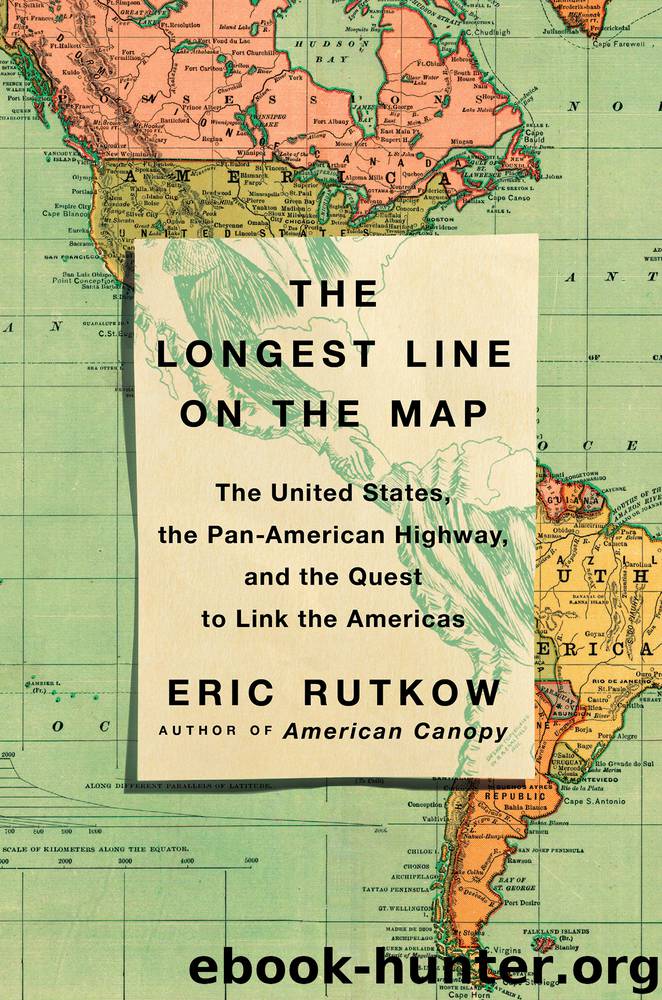The Longest Line on the Map by Eric Rutkow

Author:Eric Rutkow
Language: eng
Format: epub
Publisher: Scribner
A map comparing the route of the Inter-American Highway with that of a World War II “pioneer” road. Note in the height map at the bottom the extreme rise in southern Costa Rica, a construction job completed in 1945 that the US chief federal highway engineer considered to be the hardest road building project ever undertaken.
CHAPTER SIX
The Far Western Front
The New Roosevelt Corollary
The specter of the future Axis powers—Germany, Italy, and Japan—loomed over the approaching Eighth Pan-American Conference, scheduled to convene in December 1938 at Lima, Peru. In the words of Samuel Guy Inman, one of the US delegates,
Between 1936 and 1938 the threat to the American continent was in fact more critical than that from the Holy Alliance a century before. The three Axis powers had consolidated their forces and were driving hard against the League of Nations, then rapidly disintegrating. Axis propaganda in Latin America grew more menacing day by day. . . . Strong German colonies in Brazil, Argentina, and Chile were collaborating with reactionary, nationalistic groups. . . . A typical news dispatch of the time, coming out of Rome . . . , stated . . . that South America was the continent on which the United States and the Fascist powers were most likely to meet in mortal combat.1
Along with propaganda had also come economic infiltration. Trade between Latin America and the Nazi regime, in particular, had grown dramatically thanks to a combination of German export subsidies and a credit system—the aski mark—that limited debtor purchases to German-manufactured goods. The Cincinnati Enquirer observed shortly before the Lima conference, “Few Americans realize how keen and critical is the contest for Latin-American markets, or how directly this bears on the larger struggle for political influence there.”2
For advocates of the Pan-American Highway, the threat of fascist diffusion offered a new rationale to advance their project. One California businessman who championed the highway wrote to Roosevelt in November 1938,
It was by the transcontinental railroads that the United States was knit to the west and if we do not do the modern equivalent south of us will be what is rapidly becomming [sic] a nest of European and Japanese intrege [sic] most dangerous to our very safty [sic]. These roads built with U.S. loans never collected will cost vastly less than battleships and armaments which will not meet the need. . . . Things are developing so rapidly along medeaval [sic] lines and barbaric power is reaching out so rapidly that the need to combat it with positive action is very pressing if we are to avoid war. It may now be too late.
The businessman concluded with a plea for the upcoming Lima conference to take steps to advance the great Pan-American road project.3
The conference, however, paid little attention to the highway. The delegates instead focused on the question of “continental solidarity,” the new watchwords for a hemisphere facing a chaotic world. The conversations in Lima echoed those that had taken place two years earlier in Buenos Aires, with the United States pushing hard for a mutual defense pact and Argentina leading the resistance.
Download
This site does not store any files on its server. We only index and link to content provided by other sites. Please contact the content providers to delete copyright contents if any and email us, we'll remove relevant links or contents immediately.
| Automotive | Engineering |
| Transportation |
Machine Learning at Scale with H2O by Gregory Keys | David Whiting(3984)
Never by Ken Follett(3715)
Urban Outlaw by Magnus Walker(3310)
OPNsense Beginner to Professional by Julio Cesar Bueno de Camargo(3230)
Sapiens and Homo Deus by Yuval Noah Harari(2951)
Will by Will Smith(2745)
A Short History of Nearly Everything by Bryson Bill(2585)
Hooked: A Dark, Contemporary Romance (Never After Series) by Emily McIntire(2470)
Rationality by Steven Pinker(2235)
Borders by unknow(2155)
Holy Bible (NIV) by Zondervan(2059)
The Becoming by Nora Roberts(2038)
The One Percenter Encyclopedia by Bill Hayes(1763)
Freedom by Sonny Barger(1747)
HBR's 10 Must Reads 2022 by Harvard Business Review(1744)
A Short History of War by Jeremy Black(1732)
Five Ways to Fall by K.A. Tucker(1668)
Girls Auto Clinic Glove Box Guide by Patrice Banks(1657)
Go Tell the Bees That I Am Gone by Diana Gabaldon(1655)
